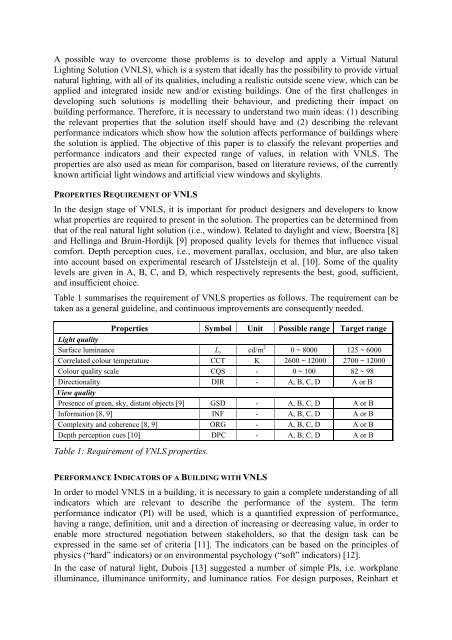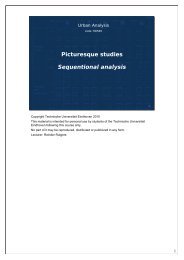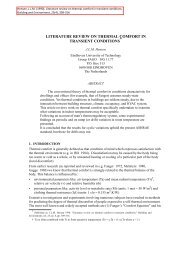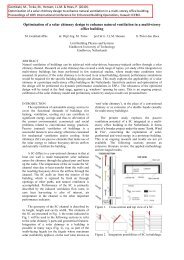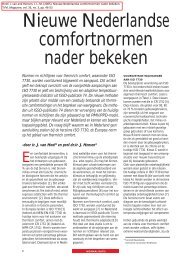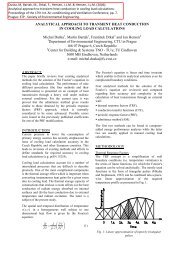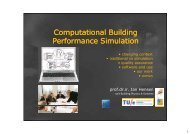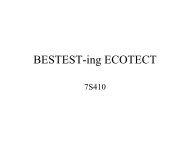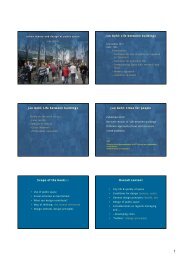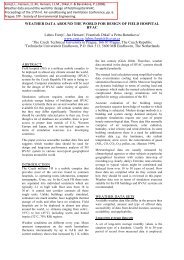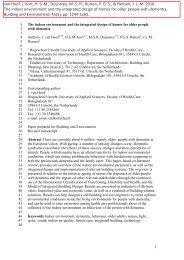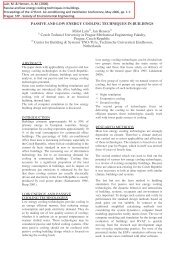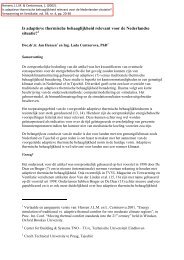properties and performance indicators of virtual natural lighting ...
properties and performance indicators of virtual natural lighting ...
properties and performance indicators of virtual natural lighting ...
Create successful ePaper yourself
Turn your PDF publications into a flip-book with our unique Google optimized e-Paper software.
A possible way to overcome those problems is to develop <strong>and</strong> apply a Virtual NaturalLighting Solution (VNLS), which is a system that ideally has the possibility to provide <strong>virtual</strong><strong>natural</strong> <strong>lighting</strong>, with all <strong>of</strong> its qualities, including a realistic outside scene view, which can beapplied <strong>and</strong> integrated inside new <strong>and</strong>/or existing buildings. One <strong>of</strong> the first challenges indeveloping such solutions is modelling their behaviour, <strong>and</strong> predicting their impact onbuilding <strong>performance</strong>. Therefore, it is necessary to underst<strong>and</strong> two main ideas: (1) describingthe relevant <strong>properties</strong> that the solution itself should have <strong>and</strong> (2) describing the relevant<strong>performance</strong> <strong>indicators</strong> which show how the solution affects <strong>performance</strong> <strong>of</strong> buildings wherethe solution is applied. The objective <strong>of</strong> this paper is to classify the relevant <strong>properties</strong> <strong>and</strong><strong>performance</strong> <strong>indicators</strong> <strong>and</strong> their expected range <strong>of</strong> values, in relation with VNLS. The<strong>properties</strong> are also used as mean for comparison, based on literature reviews, <strong>of</strong> the currentlyknown artificial light windows <strong>and</strong> artificial view windows <strong>and</strong> skylights.PROPERTIES REQUIREMENT OF VNLSIn the design stage <strong>of</strong> VNLS, it is important for product designers <strong>and</strong> developers to knowwhat <strong>properties</strong> are required to present in the solution. The <strong>properties</strong> can be determined fromthat <strong>of</strong> the real <strong>natural</strong> light solution (i.e., window). Related to daylight <strong>and</strong> view, Boerstra [8]<strong>and</strong> Hellinga <strong>and</strong> Bruin-Hordijk [9] proposed quality levels for themes that influence visualcomfort. Depth perception cues, i.e., movement parallax, occlusion, <strong>and</strong> blur, are also takeninto account based on experimental research <strong>of</strong> IJsstelsteijn et al. [10]. Some <strong>of</strong> the qualitylevels are given in A, B, C, <strong>and</strong> D, which respectively represents the best, good, sufficient,<strong>and</strong> insufficient choice.Table 1 summarises the requirement <strong>of</strong> VNLS <strong>properties</strong> as follows. The requirement can betaken as a general guideline, <strong>and</strong> continuous improvements are consequently needed.Properties Symbol Unit Possible range Target rangeLight qualitySurface luminance L s cd/m 2 0 ~ 8000 125 ~ 6000Correlated colour temperature CCT K 2600 ~ 12000 2700 ~ 12000Colour quality scale CQS - 0 ~ 100 82 ~ 98Directionality DIR - A, B, C, D A or BView qualityPresence <strong>of</strong> green, sky, distant objects [9] GSD - A, B, C, D A or BInformation [8, 9] INF - A, B, C, D A or BComplexity <strong>and</strong> coherence [8, 9] ORG - A, B, C, D A or BDepth perception cues [10] DPC - A, B, C, D A or BTable 1: Requirement <strong>of</strong> VNLS <strong>properties</strong>.PERFORMANCE INDICATORS OF A BUILDING WITH VNLSIn order to model VNLS in a building, it is necessary to gain a complete underst<strong>and</strong>ing <strong>of</strong> all<strong>indicators</strong> which are relevant to describe the <strong>performance</strong> <strong>of</strong> the system. The term<strong>performance</strong> indicator (PI) will be used, which is a quantified expression <strong>of</strong> <strong>performance</strong>,having a range, definition, unit <strong>and</strong> a direction <strong>of</strong> increasing or decreasing value, in order toenable more structured negotiation between stakeholders, so that the design task can beexpressed in the same set <strong>of</strong> criteria [11]. The <strong>indicators</strong> can be based on the principles <strong>of</strong>physics (“hard” <strong>indicators</strong>) or on environmental psychology (“s<strong>of</strong>t” <strong>indicators</strong>) [12].In the case <strong>of</strong> <strong>natural</strong> light, Dubois [13] suggested a number <strong>of</strong> simple PIs, i.e. workplaneilluminance, illuminance uniformity, <strong>and</strong> luminance ratios. For design purposes, Reinhart et


